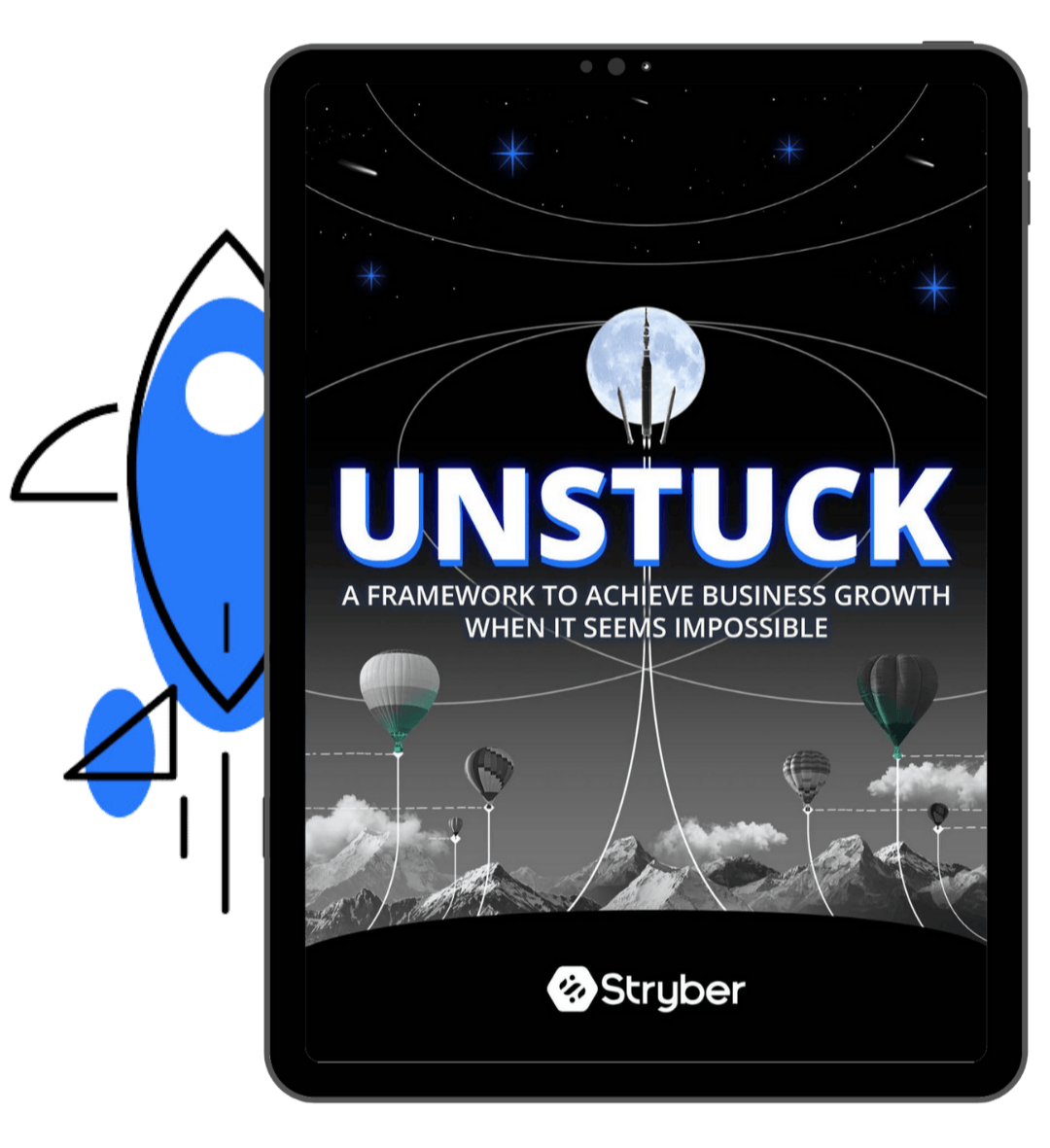Sustained business growth: why it's so hard and why gravity matters
While every business wants to grow and expand, growing a large established business in a mature market is a significant challenge. In this article, we present a new model for how to think about and discover new avenues for business growth in mature markets.
62% of CEOs named growth as their top priority in 2024. A 27% increase over last year and the highest level its been for a decade. But growth is hard. And the bigger your business, the harder it becomes.
Table of Contents
- The problem with average performance
- Why large businesses struggle to grow
- The pervasive myth of business transformation
- Your business model has an expiry date
- Gravity is slowing your growth
- Achieving escape velocity
- Introducing the Growth Sphere Model
- Which growth strategy is right for your business?
- Will surface-level strategies do the job?
- Achieving business growth with adjacent atmospheric strategies
- It's time to get Unstuck
The problem with average performance
Our Diversification Dividend research has shown that fewer than a third of firms managed to establish new revenue streams in the 10-year period studied. Other studies support this, showing average growth for a typical company hovering around 2.8% per year.
This matches the current average global economic growth rate of between 2.6% (World Bank figures) and 3.2% (OECD and IMF figures).
Average performance, it turns out, is decidedly average.
Why large businesses struggle to grow
Large established businesses operate in large established markets. They have to. Only a mature market will support them.
But mature markets have a number of low-growth features baked in:
- They tend to be relatively saturated—the total addressable market typically has little headroom for growth
- There’s a lot of competition—their size attracts entrants keen for a slice of the pie who face off against entrenched incumbents with strong brand recognition
- Opportunities for innovation are lower—most real advances have already been made, iteration rather than disruption is the name of the game
As a result, most growth in established companies happens broadly in line with overall economic growth rates.
It’s average.
The pervasive myth of business transformation
There’s a widespread misperception that we can take a large mature business, sprinkle some magic pixie dust, and transform it into something completely new.
Something better able to compete. Something impervious to stagnation and decline. Something that will outgrow market averages.
We’ve seen it in the move to more “agile” working principles.
We’ve seen it in the move to the cloud.
And right now, we’re seeing it with the ‘just-add-AI’ movement.
For most businesses, this is just an illusion.
Your business model has an expiry date
The vast majority of established businesses are virtually immune to significant transformation. The reasons are many and inescapable:
- Their governance has evolved to support a large business in a mature market—it knows nothing else
- Firmly entrenched vested interests resist change as if their futures depend on it (they do)
- Innovation is based on what the business already knows—it becomes iterative and falls foul of the Innovator’s Dilemma, rarely able to look beyond the H1 horizon
- Legacy systems and processes are complex, multi-layered, and self-reinforcing—no one wants to mess with this house of cards
- Customers often don’t want radical change—they want what they know, just a bit better and a lot cheaper
We could go on.
The uncomfortable truth is that virtually every business has an expiry date deeply embedded into its business model.
It may be able to slow its decline a little (say, by buying a competitor or gaining temporary ground with some innovation to existing products) but the writing is on the wall.
Gravity is slowing your growth
Quick physics lesson: everything exerts a gravitational pull on everything else. Us, you, Jupiter, the nearest black hole—everything.
The bigger the object, the stronger its gravitational field.
To get clear of Earth’s gravity, we’ll need to hit an escape velocity of a little over 11 km/s at the surface. To do the same on Jupiter, we’d need to achieve over 5x that.
Gravity matters.
How does this apply to business growth?
The larger a business, the more gravity it exerts on everything around it. Think of this like the surface of a planet. A big one.

Achieving escape velocity
For any growth initiative to get off the ground, it will need to escape the gravity of the core business.
It doesn’t matter whether we’re talking about new products, new routes to market, new business models, new diversified offerings etc.
The same rules apply.
Yet everything will try to pull these back to the surface.
This is precisely why so many businesses stick to market penetration strategies. They represent business as usual.
Of course, more often than not, they also merely deliver the usual average results.
Ultimately, they never achieve the required escape velocity to drive real change.
Introducing the Growth Sphere Model
This concept of organizational gravity is a useful framework for exploring possible business growth strategies for our companies.
It’s a tool we use to identify where companies should (and shouldn’t) invest time, money, and effort to grow their businesses.
The Growth Sphere Model splits growth strategies into three gravitational fields: Core, Adjacent, and Detached.
Gravity is strongest at the Core and weakest (or non-existent) when Detached.
We’ll summarize the model below before giving pointers on which strategies may work for your business.
Core-level business growth strategies
The Core level involves growth strategies focused on an existing organization’s core business.
Fundamentally, these look to expand market penetration—whether you opt to build something new or buy something that already exists.
There are two core Core strategies businesses can pursue:
- Innovating existing products and services (sustaining innovation)
- Merger and acquisition deals that absorb acquired entities into the core through post-merger integration (M&A PMI)
Adjacent-level business growth strategies
The Adjacent level aims for adjacent diversification.
These approaches look to create or acquire a new entity that is at least partly different from the existing legacy core business.
The innovations and additions these bring to the organization will leverage existing core assets to an extent. And the result will create an additional business within the organization.
There are three broad Adjacent strategies available:
- Build a new diversified business offering (adjacent innovation)
- Bolt-on an acquisition through an M&A deal (bolt-on M&A)
- Implement a combination of both (buy and build)
Growing a business through detached strategies
Finally, there are Detached approaches that focus on non-adjacent or detached diversification.
This is the process of adding new businesses and market offerings that have almost nothing in common with the core organization. There is little or no gravity involved.
There are two main Detached options available:
- Build new, un-related standalone businesses within the organization (detached innovation)
- Buy an unrelated business and run it as a near-independent entity (conglomeration)
It's time to get Unstuck
If you're leading an established business with persistent growth challenges, we've published a new in-depth framework which includes a detailed look at our Growth Sphere Model.
In the framework, we explore why so many large organizations struggle with growth. Finally, we unpack the most-used strategies deployed by businesses today. We analyze their pros and cons and highlight why you may or may not want to explore them for your business.
Which growth strategy is right for your business?
There is no one-size-fits-all strategy for consistently growing a large, established business.
However, there are some one-size-fits-no-one strategies—the Detached ones.
Detached innovation is a high-risk approach with no safety nets. You cannot build on existing knowledge and capabilities. And the resulting business won’t benefit from a parenting advantage from the core organization.
Conglomeration is one of the fastest ways to destroy value in a business.
The “conglomeration discount” is well documented and conglomerates are complex and difficult to manage. Avoid.
So if we ignore Detached, what about options closer to home?
Will core-level strategies do the job?
Most companies focus most of their attention on Core strategies around increasing market penetration—sustaining innovation and M&A PMI.
Both of these are viable under certain circumstances.
If your market isn’t saturated yet and there is plenty of room for significant product development, a sustaining innovation approach can offer a solid route forward.
You may be able to build on a strong brand and a large existing customer base to grow.
Alternatively, if you can acquire and integrate a good-fit M&A target at a reasonable price that will add capabilities that are missing in your core organization, this could rapidly accelerate your growth trajectory.
But many businesses struggle.
If their markets aren’t already saturated, they soon will be. And finding good-fit acquisition targets is often difficult.
Achieving business growth with adjacent atmospheric strategies
This leaves us with the Adjacent strategies—bolt-on M&A, adjacent innovation, and buy and build.
We are not an impartial observer.
We’ve seen the success large, mature businesses have achieved through adjacent Adjacent strategies that result in profitable diversification.
Our data shows that those who’ve successfully diversified generate 53% higher annual total shareholder return (TSR) than those focused solely on their core business.
Bolt-on M&As offer powerful opportunities for the acquiring company to use its own capabilities to make the acquired entity more successful.
Adjacent innovation can enable established businesses to explore new business models free from the gravity holding the core organization back.
And buy and build strategies can radically accelerate innovation, helping businesses leapfrog their competition.
Of course, you need to adopt the right approach to any growth strategy. Executed badly, you will still fail to realize the results you need to see.
But with the right methodology, data, and expertise, Adjacent growth strategies offer the sweet spot for most established businesses most of the time.
Want to discuss how Stryber can help?

You may also like
These related articles

Finding growth from your core: when to pursue market penetration strategies

The 8 great myths of corporate innovation

